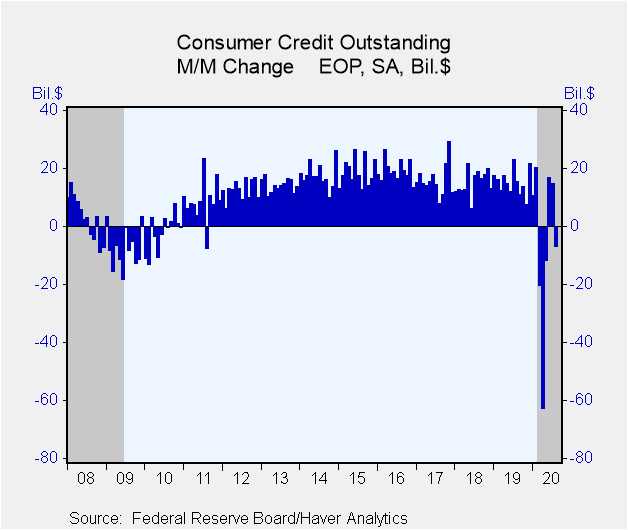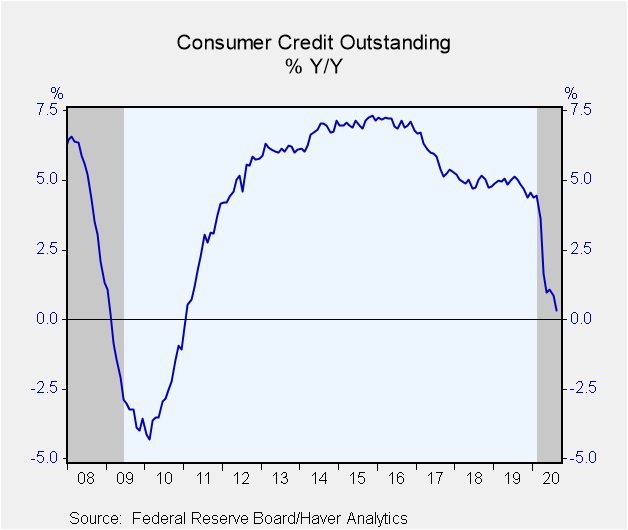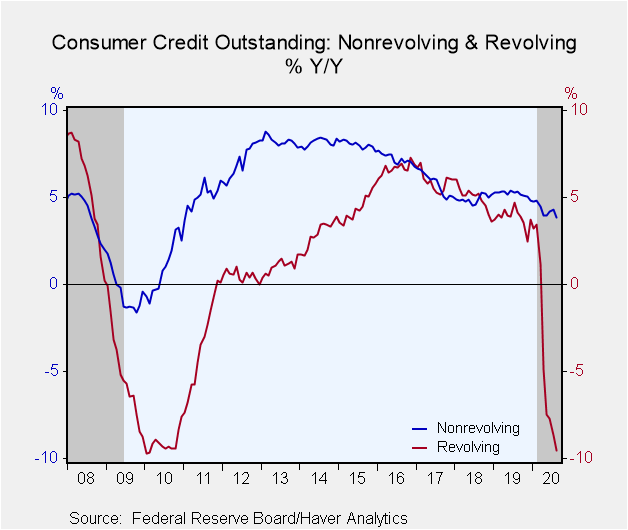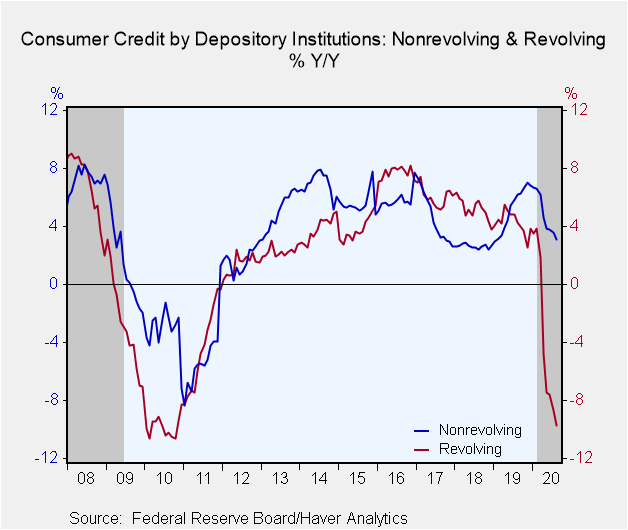 Global| Oct 07 2020
Global| Oct 07 2020U.S. Consumer Credit Usage Surprisingly Reverses Course in August
by:Tom Moeller
|in:Economy in Brief
Summary
• Nonrevolving borrowing edges higher. • Credit card balances are being liquidated. Consumers recently grew cautious about using credit. Consumer credit outstanding declined $7.2 billion during August following two months of double- [...]
• Nonrevolving borrowing edges higher.
• Credit card balances are being liquidated.
Consumers recently grew cautious about using credit. Consumer credit outstanding declined $7.2 billion during August following two months of double-digit gain. So far this year, consumer credit has declined 10.3%. A $14.1 billion increase had been expected by the Action Economics Forecast Survey.
Revolving consumer credit balances pulled back $9.4 billion (-9.6% y/y) in August, down for the seventh month this year. Credit provided by depository institutions, 90% of the total and mostly credit card debt, declined 9.7% y/y. Credit union borrowing fell 4.7% y/y and finance company loans were off 21.4% y/y.
Nonrevolving credit usage edged $2.2 billion higher (3.8% y/y) after double-digit increases in each of the prior three months. Federal government borrowing, which uses over 40% of nonrevolving credit, grew 5.6% y/y. Depository institution loans (29% of credit) gained a greatly lessened 3.1% y/y, down from 6.8% y/y growth as of December. Finance company borrowing (16.0% of loans) rose 2.3% y/y and credit union loans (14.0% of the total) increased 2.8% y/y.
These Federal Reserve Board figures are break-adjusted and calculated by Haver Analytics. The breaks in the series in 2005, 2010 and 2015 are the result of the incorporation of the Census and Survey of Finance Companies, as well as changes in the seasonal adjustment methodology.
The consumer credit data are available in Haver's USECON database. The Action Economics figures are contained in the AS1REPNA database.
Recent Economic Developments and the Challenges Ahead from Federal Reserve Chair Jerome H. Powell is available here.
| Consumer Credit Outstanding (M/M Chg, SA) | Aug | Jul | Jun | Aug y/y | 2019 | 2018 | 2017 |
|---|---|---|---|---|---|---|---|
| Total ($ bil) | -7.2 | 14.7 | 16.9 | 0.3% | 4.6% | 4.8% | 5.3% |
| Nonrevolving | 2.2 | 14.9 | 18.6 | 3.8 | 4.9 | 5.2 | 5.1 |
| Revolving | -9.4 | -0.2 | -1.7 | -9.6 | 3.8 | 3.6 | 6.0 |
Tom Moeller
AuthorMore in Author Profile »Prior to joining Haver Analytics in 2000, Mr. Moeller worked as the Economist at Chancellor Capital Management from 1985 to 1999. There, he developed comprehensive economic forecasts and interpreted economic data for equity and fixed income portfolio managers. Also at Chancellor, Mr. Moeller worked as an equity analyst and was responsible for researching and rating companies in the economically sensitive automobile and housing industries for investment in Chancellor’s equity portfolio. Prior to joining Chancellor, Mr. Moeller was an Economist at Citibank from 1979 to 1984. He also analyzed pricing behavior in the metals industry for the Council on Wage and Price Stability in Washington, D.C. In 1999, Mr. Moeller received the award for most accurate forecast from the Forecasters' Club of New York. From 1990 to 1992 he was President of the New York Association for Business Economists. Mr. Moeller earned an M.B.A. in Finance from Fordham University, where he graduated in 1987. He holds a Bachelor of Arts in Economics from George Washington University.










